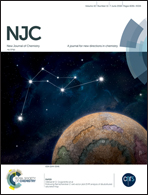Positional isomers of mannose–quinoline conjugates and their copper complexes: exploring the biological activity†
Abstract
8-Hydroxyquinolines show a wide range of pharmacological activities, and some are marketed as therapeutic agents. Despite the significant number of biologically active hydroxyquinolines proposed, there is a continued interest in the development of new active derivatives to overcome the drawbacks associated with their use. Herein, we report the synthesis and characterization of a set of positional isomers of hydroxyquinoline–mannose conjugates. Since in many cases the complexation ability of 8-hydroxyquinolines seems to be responsible for their pharmacological activities, we investigated the capacity of these systems to complex copper(II) ions. We also examined diverse biological activities (antiproliferative, antimicrobial and antioxidant) of the new derivatives and their copper(II) complex and compared them to those of their parent compounds and an analogous glucose–quinoline conjugate. All compounds show antioxidant activity that depends on the regioisomer. Moreover, specific isomers show significant antibacterial activity against P. aeruginosa and S. aureus. Furthermore only a regioisomer shows a pharmacologically relevant antiproliferative activity against human tumor cells, in the presence of copper(II) ions.



 Please wait while we load your content...
Please wait while we load your content...